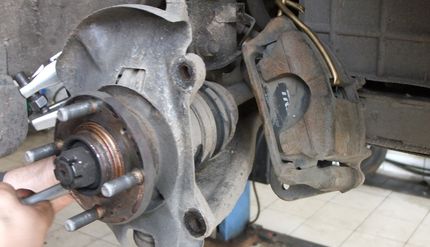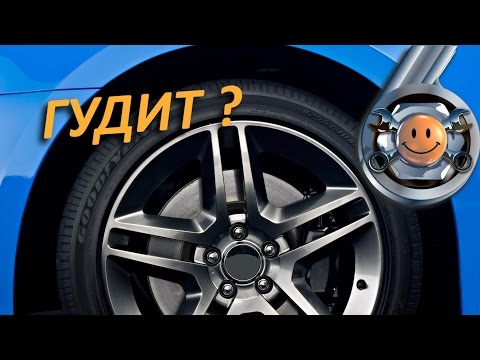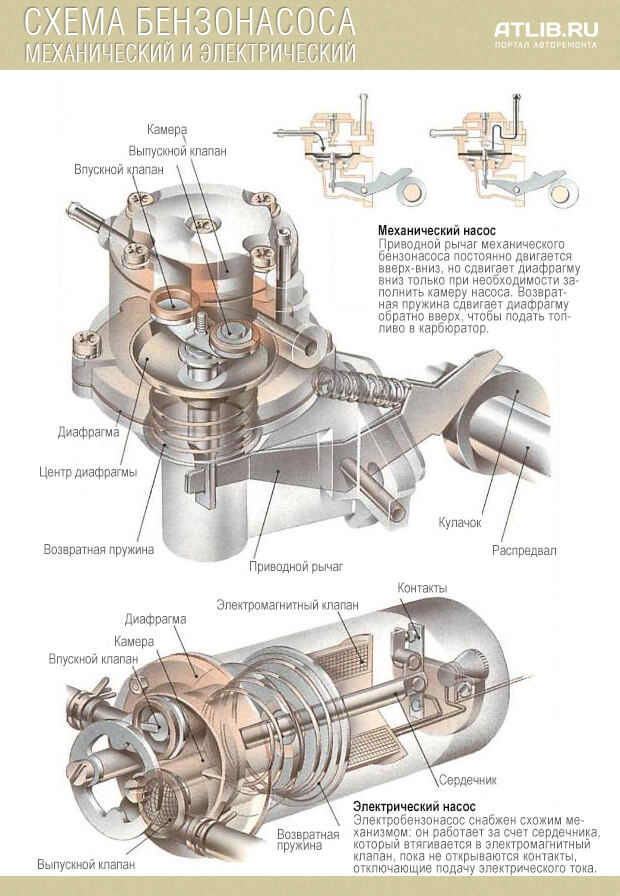
How to check the hub
Content
Wheel bearing check - the lesson is simple, but it requires certain knowledge and skills from the car owner. Bearing condition diagnostics can be done in garage conditions and even just on the road. Another thing is that the hum coming from the hub assembly may not always signal that it is the wheel bearing that has failed.
Why is the hub buzzing
There are actually several reasons why a hum or knock appears in the area of \uXNUMXb\uXNUMXbthe wheel bearing. So, unpleasant creaking sounds can be a sign of a partial failure of the steering rod, tip, ball joint, worn silent blocks, and also from the wheel bearing. And it is the bearing that most often causes the hum.
As a wheel bearing, a closed type of bearings is used. This is due to the fact that when driving a car, sand, dirt, dust and other abrasive elements cannot be allowed to enter the bearing housing. In general, there is six basic reasons, according to which a situation may arise when the wheel bearing partially fails and begins to creak.
- Significant mileage. This is a natural cause of wear on the inner surface of the bearing housing, where the ball grooves in it expand and the bearing begins to knock. This usually happens after 100 thousand kilometers (depending on the specific car, bearing brand, the nature of the car).
- Loss of tightness. The closed type bearing housing has rubber and/or plastic casing inserts that cover the bearing balls from the external environment. The fact is that inside the bearing there is a small amount of grease that ensures its normal operation. Accordingly, if such inserts are damaged, the lubricant flows out, and the bearing starts to work “dry”, and, accordingly, sharp wear occurs.
- Sloppy driving. If the car often flies at high speed into pits, potholes, runs into bumps, then all this breaks not only the suspension, but also the hub itself.
- Incorrect pressing. This is a fairly rare cause, however, if an inexperienced (or unskilled) person did the installation of the bearing during the last repair, then it is quite possible that the bearing was installed obliquely. In such conditions, the node will work only a few thousand kilometers.
- Incorrect hub nut tightening torque. The technical documentation for the car always clearly indicates with what torque the hub nut must be tightened and sometimes how to tighten in order to adjust the hub. If the torque value is exceeded, then it will begin to overheat while driving, which will naturally reduce its resource.
- Riding through puddles (water). This is a rather interesting case, which lies in the fact that when moving, any, even a serviceable bearing, heats up, and this is normal. But when entering cold water, the air inside it is compressed and it sucks moisture into the bearing housing itself through not very dense rubber seals. This is especially true if the gum is already old or simply rotten. Moreover, the crunch itself usually does not appear immediately, but may appear after one or two days, when corrosion is formed in the bearing, albeit small.
In addition to those listed above, there are also a number of less common reasons for a hub bearing to crackle while driving:
- Manufacturing defects. This reason is relevant for inexpensive bearings made in China or Russia. This may be expressed in different ways. For example, inaccurate observance of dimensions and tolerances, poor-quality sealing (seal), little special lubricant.
- Incorrect wheel offset. This naturally leads to an increase in the load on the wheel bearing, which shortens its life and can lead to the appearance of a crunch in it.
- Frequent operation of an overloaded vehicle. Even if the car drives on good roads, it must not be significantly and / or often overloaded. This similarly leads to an increase in the load on the bearings with the consequences indicated above.
- Too big tire radius. This is especially true for jeeps and commercial vehicles. If the tire diameter is large, then during lateral acceleration, an additional destructive force will act on the bearing. namely, the front hubs.
- Defective shock absorbers. When the suspension elements of the car do not properly cope with their tasks, then when driving on bad roads, the load on the hub bearings in the vertical plane increases, which reduces their overall life. Therefore, you need to make sure that the suspension of the car works in its normal mode. Especially if the machine is often used on bad roads and/or is often heavily loaded.
- breakdowns in the brake system. Often, the temperature of the brake fluid and / or the temperature of the brake disc (drum) will be high, and heat energy will be transferred to the wheel bearing. And overheating reduces its resource.
- incorrect camber/toe-in. If the wheels are installed at the wrong angles, then the load forces will be incorrectly distributed to the bearings. Accordingly, on one side the bearing will experience an overload.
Signs of a failed wheel bearing
The reason for checking the wheel bearing of a car may be one or more of the following symptoms:
- The appearance of a hum (similar to a “dry” crunch) from the wheel. usually, the hum appears when the car exceeds a certain speed (usually this value is about 60 ... 70 km / h). The hum increases when the car enters turns, especially at high speeds.
- Often, along with the hum, a vibration appears not only on the steering wheel, but on the entire car (due to the beating of the bearing), which is felt when driving, especially on a smooth road.
- Overheating of the rim during a long drive. In some cases, the brake caliper overheats to the point that the brake fluid can boil.
- Wheel wedging. For the driver, this is expressed in such a way that when driving in a straight line, the car seems to “pull” to the side. This is due to the fact that the problematic bearing slightly slows down the wheel associated with it. The symptoms are similar to those that appear when the wheel alignment is set incorrectly. This behavior is already very dangerous, because if the wheel bearing jams, it can break the CV joint, and at speed the disk will cut the tire!
How to check the hub bearing
There are four basic methods by which any car enthusiast can check the condition of the hub.
Plane check

Video how to check the wheel bearing
This is the simplest method and can be used to check the wheel bearing right outside the garage or driveway. So, for this you need to drive the car onto a flat asphalt (concrete) area. then we take the problematic wheel at its highest point with our hand and try with all our might to swing it with movements away from ourselves and towards ourselves. If at the same time there are metallic clicks - it means the bearing has come to an endand it needs to be changed!
When obvious clicks are not heard during such an operation, but suspicions remain, you need to jack up the car from the side of the wheel being studied. After that, you need to manually give the wheel rotational movements (if this is a drive wheel, then you must first remove the machine from the gear). If there is extraneous noise during rotation, the bearing buzzes or crackles - this is additional confirmation that the hub is out of order. With a defective bearing during rotation, it seems that the wheel does not sit securely in its place.
also, when jacking up, you can loosen the wheel not only in the vertical plane, but also in the horizontal and diagonal. This will give more information. In the process of rocking, be careful so that the machine does not fall off the jack! So, you need to take the upper and lower points of the wheel with your hand and try to swing it. If there is play, it will be noticeable.
The described method is suitable for diagnosing both front and rear wheel bearings.
Checking the hub for runout
An indirect sign of deformed hubs will be a beating in the pedal when braking. This can be caused by both brake disc wobble and hub wobble. And in some cases, the brake disc under the influence of temperature itself is deformed after the hub. Deviations from the vertical plane even by 0,2 mm already cause vibrations and beating at speed.
The maximum allowable beat indicator should not exceed the mark 0,1 mm, and in some cases this value may be less - from 0,05 mm to 0,07 mm.
At the service station, the hub runout is checked with a dial gauge. Such a pressure gauge leans against the plane of the hub and shows the exact value of the runout. In garage conditions, when there is no such device, they use a screwdriver (it allows you to make a conclusion if the hub or the disk itself hits).
The algorithm for checking the hub for runout with your own hands will be as follows:
- Remove the required wheel.
- We take a head with a collar, with their help we will spin the wheel by the hub nut.
- We take a flat screwdriver, rest it on the caliper bracket and bring it with a sting to the working surface of the rotating brake disc (closer to its edge). must be held so still in the process of rotation.
- If the brake disc has a runout, the screwdriver will leave scratches on its surface. And not along the entire circumference, but only on an arc that sticks out in a horizontal plane.
- any disk needs to be checked on both sides.
- If a “crooked” place was found on the disk, then you need to disconnect it from the hub, rotate 180 degrees and reinstall on the hub. At the same time, it is securely fastened with the help of mounting bolts.
- then we repeat the procedure for finding bulges on the test disk.
- When, if the newly formed arc-scratch is located on top of the already drawn - means, curved brake disc.
- In the case when, as a result of the experiment two arcs were formedlocated on the disk opposite to each other (by 180 degrees) means crooked hub.
Lift check
this method is best for front wheel drive vehicles as they have a more complex front wheel bearing design than rear wheel drive vehicles. However, it can also be used to diagnose rear- and all-wheel drive vehicles.
in order to check the wheel bearings, you need to drive the car onto a lift, start the internal combustion engine, turn on the gear and accelerate the wheels. Then turn off the engine and listen to how the bearings work in the process of stopping the wheels. If any of the bearings is defective, then it will be clearly audible by the crunch and vibration on a particular wheel.
How to check the hub on the jack (front and rear)
Whether the wheel bearing is buzzing or not, you can also check it on a jack. Moreover, it is desirable to work in a closed garage or in a box, because this way the sounds will be felt much better than on the street. We jack up the car alternately under the lever of one of the wheels. When you do not know which wheel hub is making noise, it is recommended to start with the rear wheels, and then the front. this must be done in series with the wheels of the same axle. The procedure is as follows:
How to check a wheel bearing on a jack
- Jack up the wheel to be checked.
- We turn the rear wheels manually (on the front-wheel drive) and listen.
- To check the front wheels, you need to depress the clutch (for a manual transmission), start the internal combustion engine, engage 5th gear and smoothly release the clutch.
- In this case, the suspended wheel will rotate at a speed corresponding to approximately 30 ... 40 km / h.
- If the hub bearing is damaged, then it will be perfectly audible to the person standing in close proximity to it.
- After acceleration, you can set the neutral gear and turn off the internal combustion engine in order to allow the wheel to stop on its own. This will eliminate additional internal combustion engine noise.
Notethat you can’t leave the car in this mode for a long time, the verification procedure should take a few minutes! In an all-wheel drive vehicle, it is imperative to disable the drive of the second axle. If this is not possible, then you only need to check it on a lift, hanging the entire machine.
How to check in motion (front hub check)
It is possible to indirectly diagnose the failure of a wheel bearing while on the road. To do this, you need to find a flat, preferably paved, area. And on it to ride a car at a speed of 40 ... 50 km / h, while entering turns.
The essence of the check is that when turning to the left, the center of gravity of the car shifts to the right, and accordingly, an additional load is placed on the right wheel bearing. At the same time, it starts to make additional noise. When exiting a turn, the noise disappears. Similarly, when turning right, the left wheel bearing should rustle (if it is faulty).
when driving on a straight smooth road, a partially failed wheel bearing begins to make noise when the car picks up a certain speed (usually the sound begins to be felt at a speed of about 60 km / h). And as it accelerates, the noise increases. However, if such sounds occur, then it is advisable not to accelerate much. Firstly, it is unsafe, and secondly, it also leads to more wear on the bearing.
Especially clearly the rumble is heard when driving on smooth asphalt. This is due to the fact that when driving on coarse-grained asphalt, the noise from the ride itself is quite noticeable, so it simply muffles the rumble of the bearing. But when driving on a good surface, the sound is felt "in all its glory."
Rim temperature
This is a very indirect sign, but you can also pay attention to it. So, a worn wheel bearing gets very hot during its operation (rotation). The heat radiated by it is transferred to the metal parts adjacent to it, including the rim. Therefore, in the process of driving, without pressing the brake pedal (in order not to heat the brake disc), you just need to stop by coasting. If the disc is warm, this is an indirect sign of a failed wheel bearing. However, here it must be borne in mind that the tires also heat up during the ride, so this method is best performed in moderate weather (spring or autumn).
What happens if you do not change the bearing when it is buzzing
If an unpleasant suspicious hum appears when accelerating to a certain speed and / or entering turns, the hub should be checked as soon as possible. Using a car with a broken wheel bearing is not only harmful to the car, but also dangerous!
What happens if the wheel bearing jams. clearly
So, if you do not change the failed wheel bearing in time, then this can threaten (or several at the same time) emergencies:
- Additional load (vibration) on the chassis of the car, its steering. This leads to a decrease in the resource of their individual parts and assemblies.
- The thrust of the internal combustion engine, its efficiency is reduced, which can lead, among other things, to an increase in fuel consumption.
- Brake fluid may boil due to overheating of the brake assembly. This will lead to partial and even complete failure of the braking system!
- When turning, the wheel may simply “lie down”, which will lead to loss of control over the car. At speed, this can be fatal!
- With critical wear, the bearing can jam, which will lead to wheel stop. And if such a situation occurs in motion, it can cause a significant accident!
